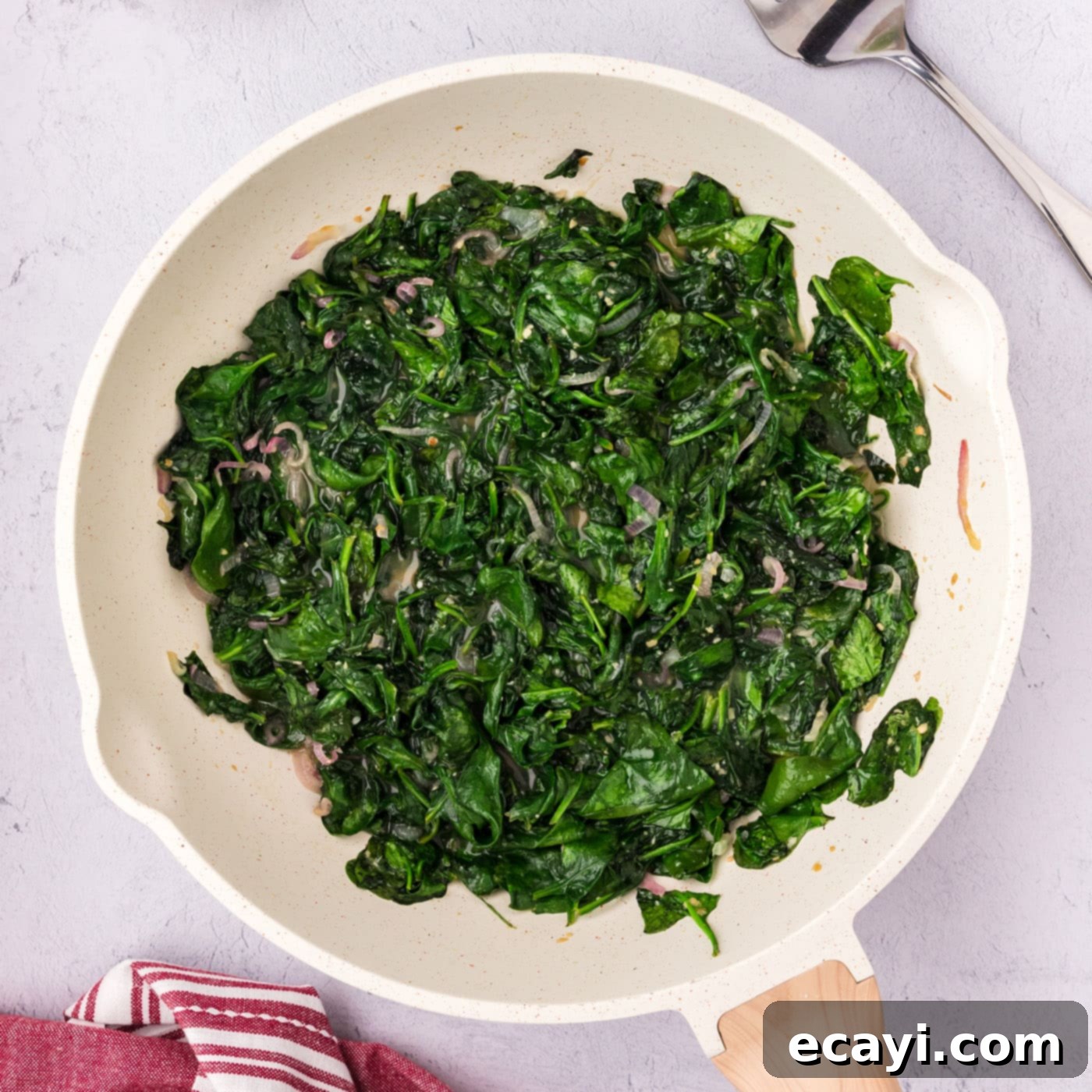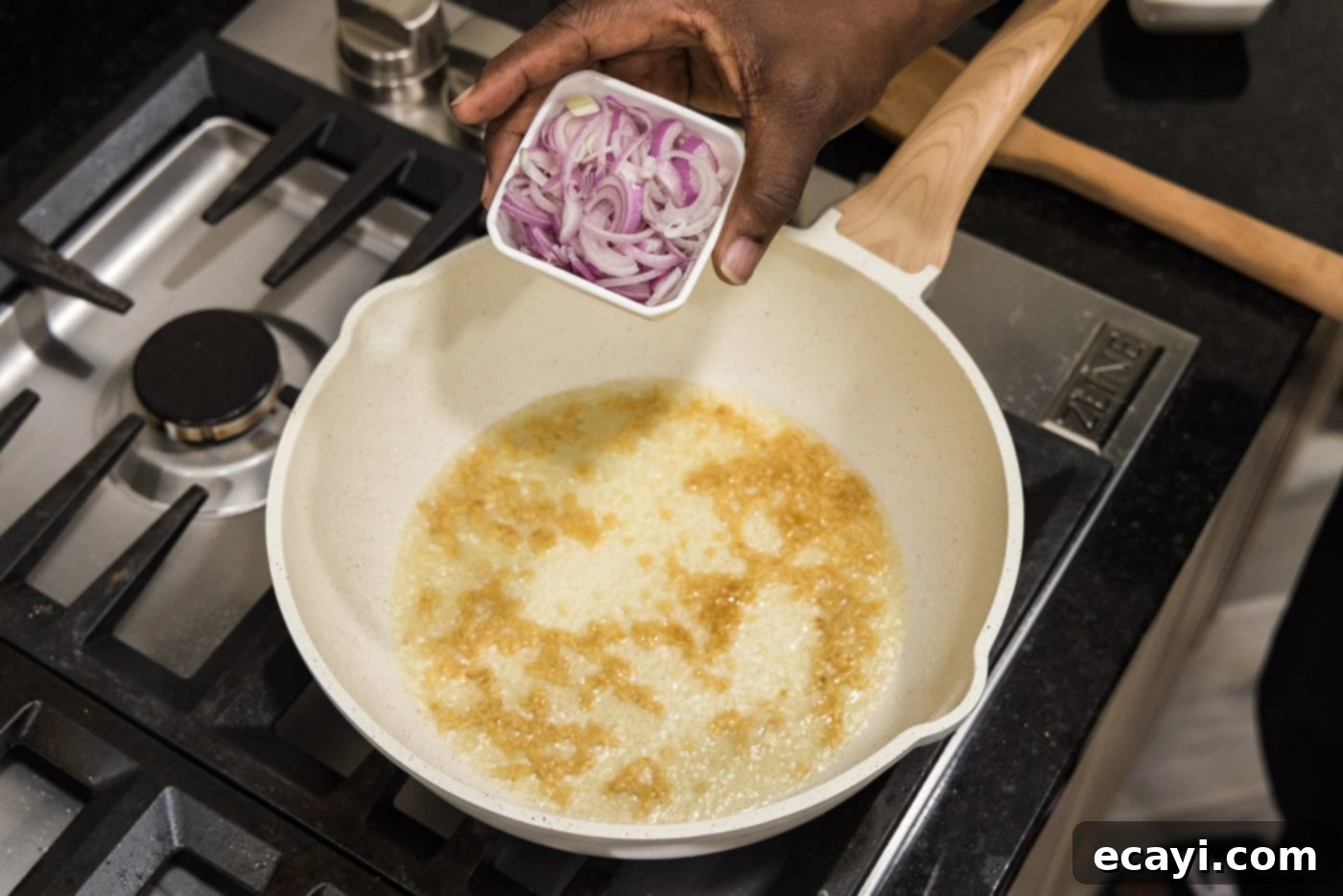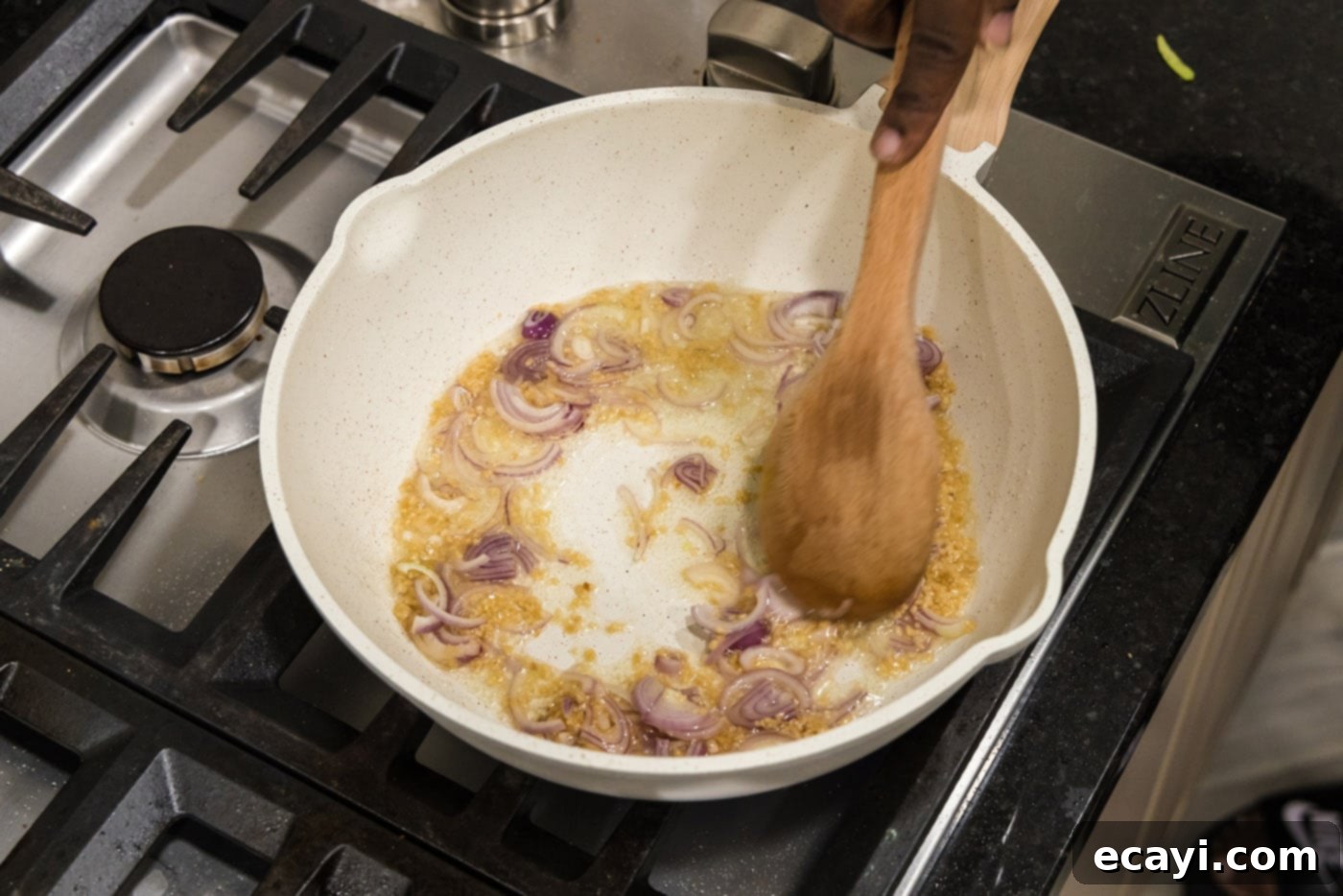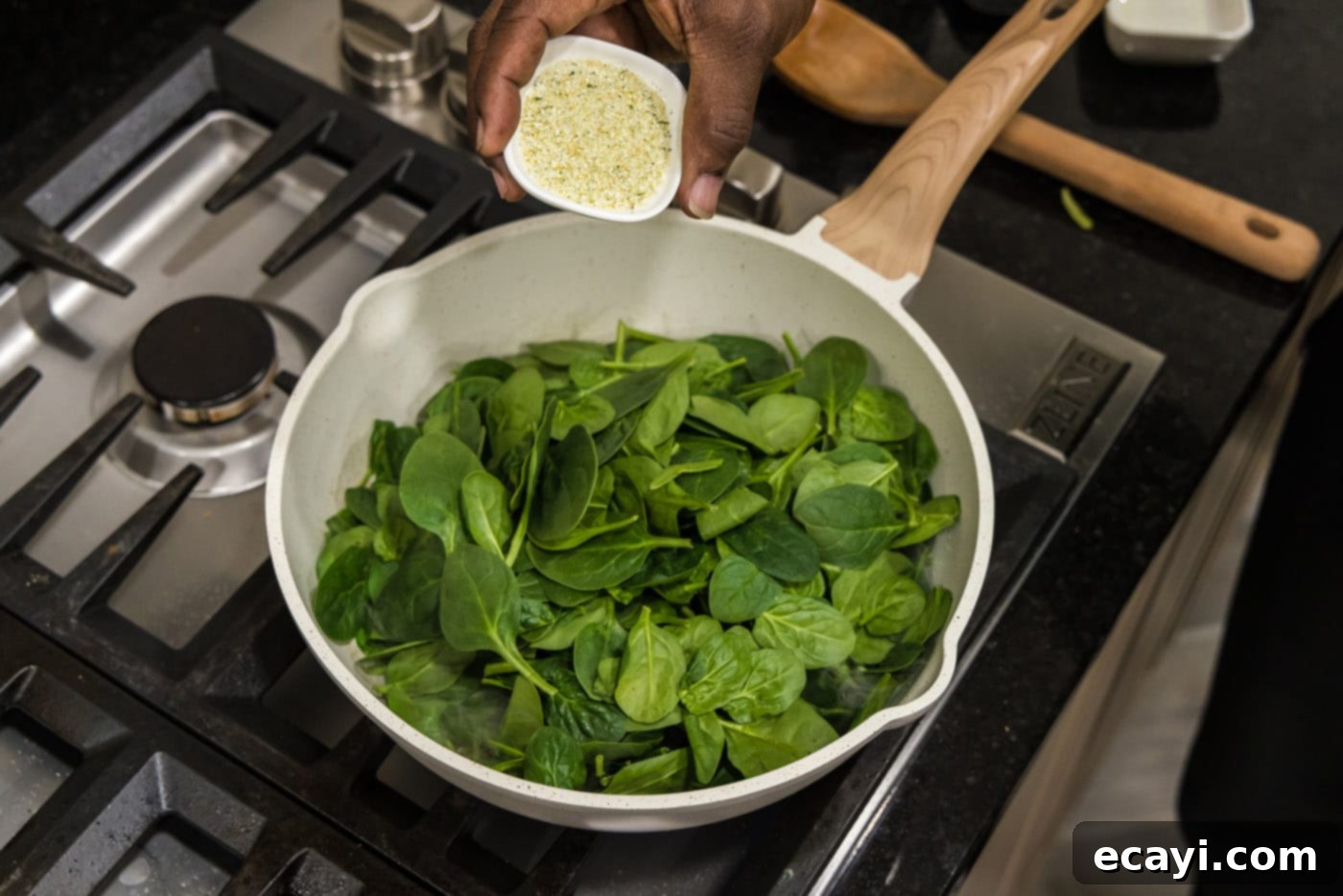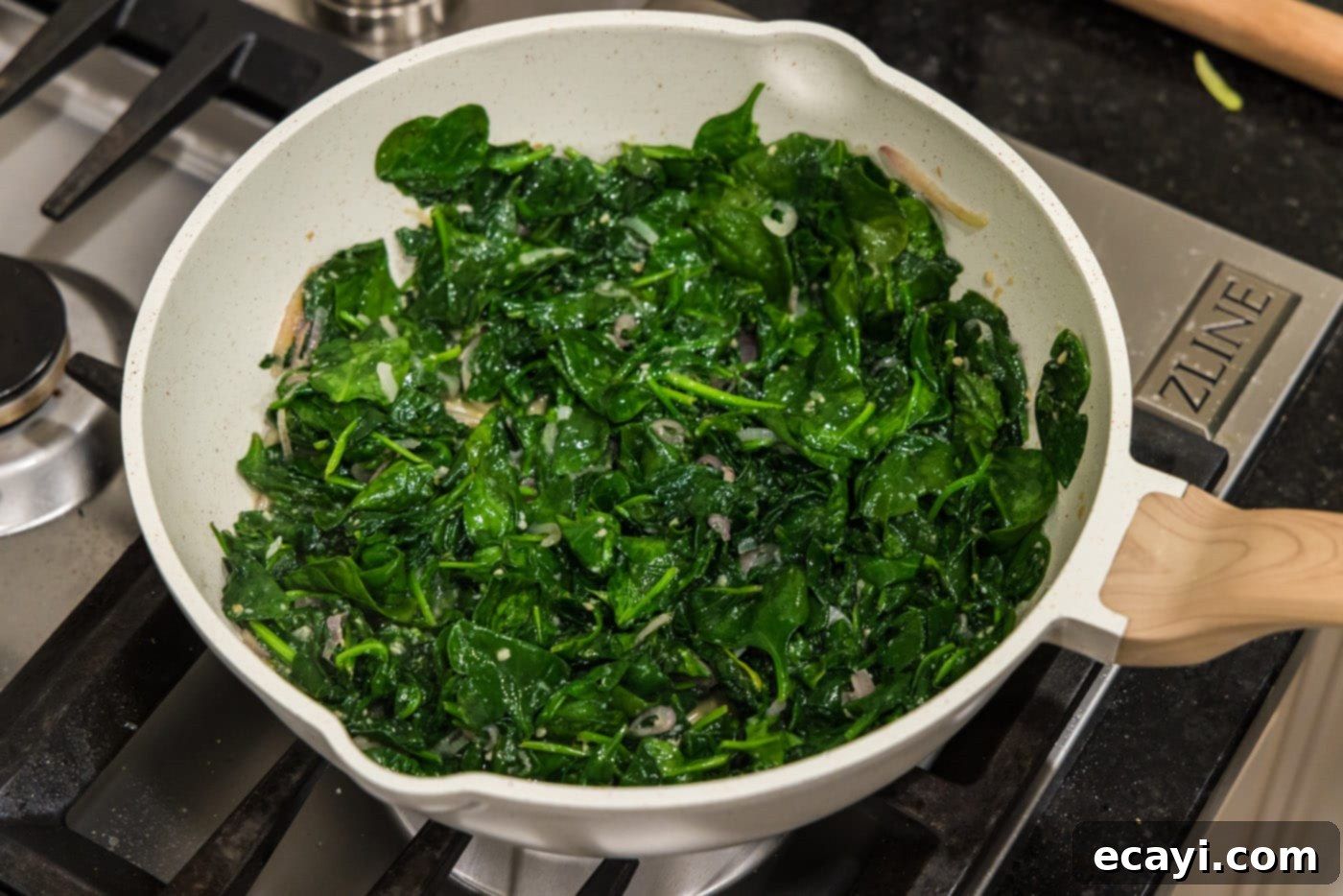Effortlessly Delicious Sautéed Spinach with Garlic & Shallots: A Quick & Healthy Side Dish
Discover the secret to a perfect, vibrant side dish that’s ready in just 10 minutes: our irresistible sautéed spinach. Infused with aromatic garlic and savory shallots, and kissed with a touch of olive oil, this recipe is a masterclass in transforming simple greens into a flavor-packed, nutrient-dense delight. Whether you’re a seasoned chef or a beginner in the kitchen, this easy-to-follow method promises a dish that’s not only incredibly good for you but also utterly delicious.
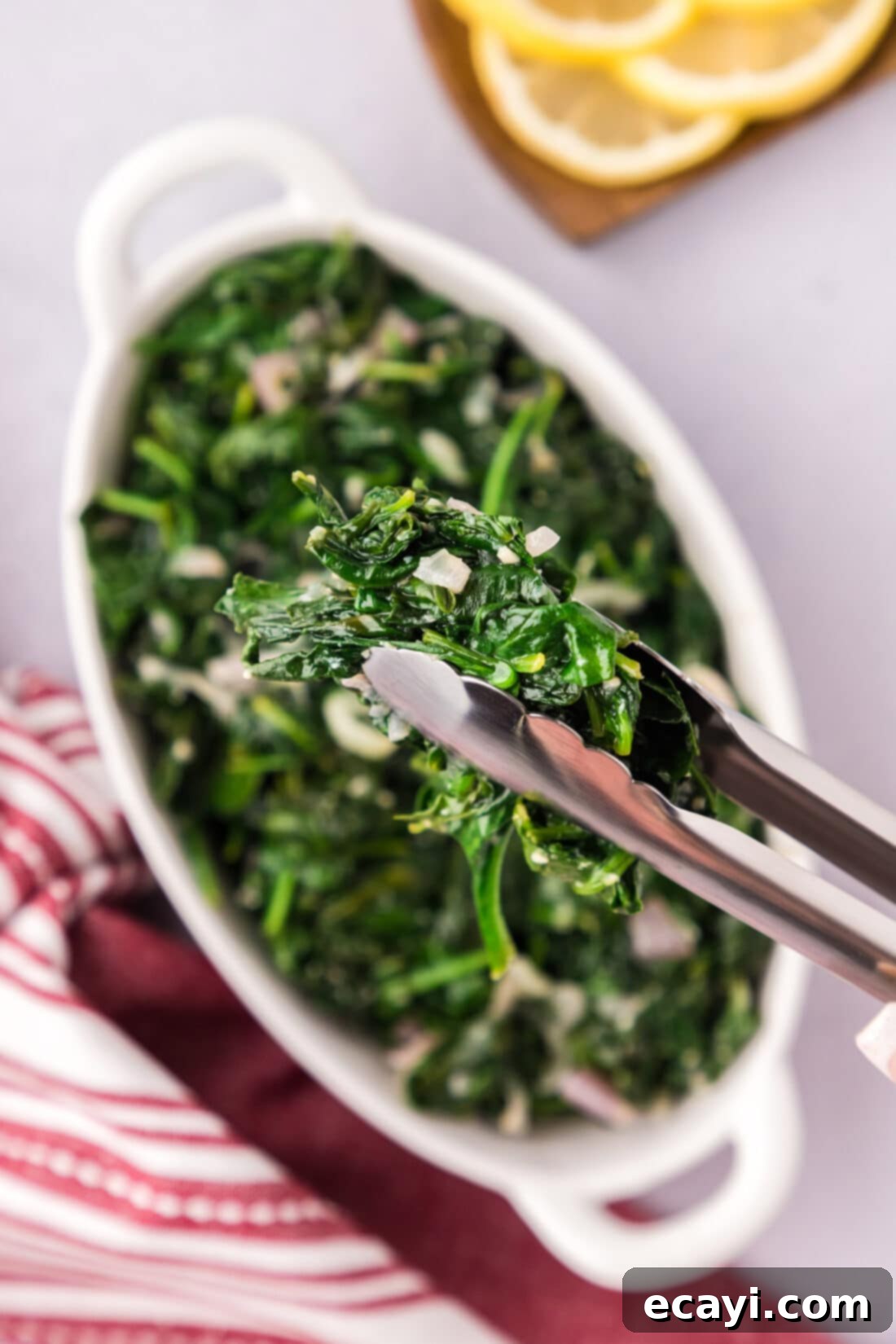
Why You’ll Adore This Sautéed Spinach Recipe
There are countless reasons why this sautéed spinach recipe deserves a permanent spot in your culinary repertoire. It’s an incredibly efficient way to incorporate more greens into your diet, requiring minimal preparation and delivering maximum flavor. We confidently declare it one of our absolute favorite methods for preparing spinach – it’s simply that easy and that satisfying!
Spinach is truly a nutritional powerhouse, brimming with essential vitamins and minerals. It’s an excellent source of vitamin K, vital for blood clotting and bone health, and a significant contributor of iron, crucial for energy and oxygen transport. Beyond these, spinach boasts high levels of vitamin A (especially when cooked), which supports vision and immune function, as well as vitamin C for immunity, folate for cell health, and potassium for blood pressure regulation. Its rich content of antioxidants like lutein and zeaxanthin are particularly beneficial for maintaining robust eye health, protecting against age-related macular degeneration. Additionally, the magnesium in spinach contributes to a strong immune system and muscle function, while vitamin E offers further antioxidant protection.
This leafy green vegetable is incredibly versatile. Enjoy it fresh in vibrant salads, such as our refreshing spinach salad with mango and avocado, or blend it into invigorating tropical smoothies for a hidden dose of goodness. However, sautéing spinach in a hot skillet truly brings out its tender texture and slightly sweet, earthy flavor, making it a perfect healthy green to complement any main course. For those who adore robust flavors, don’t hesitate to load your skillet with extra minced garlic to create an even more savory and aromatic garlic spinach experience!
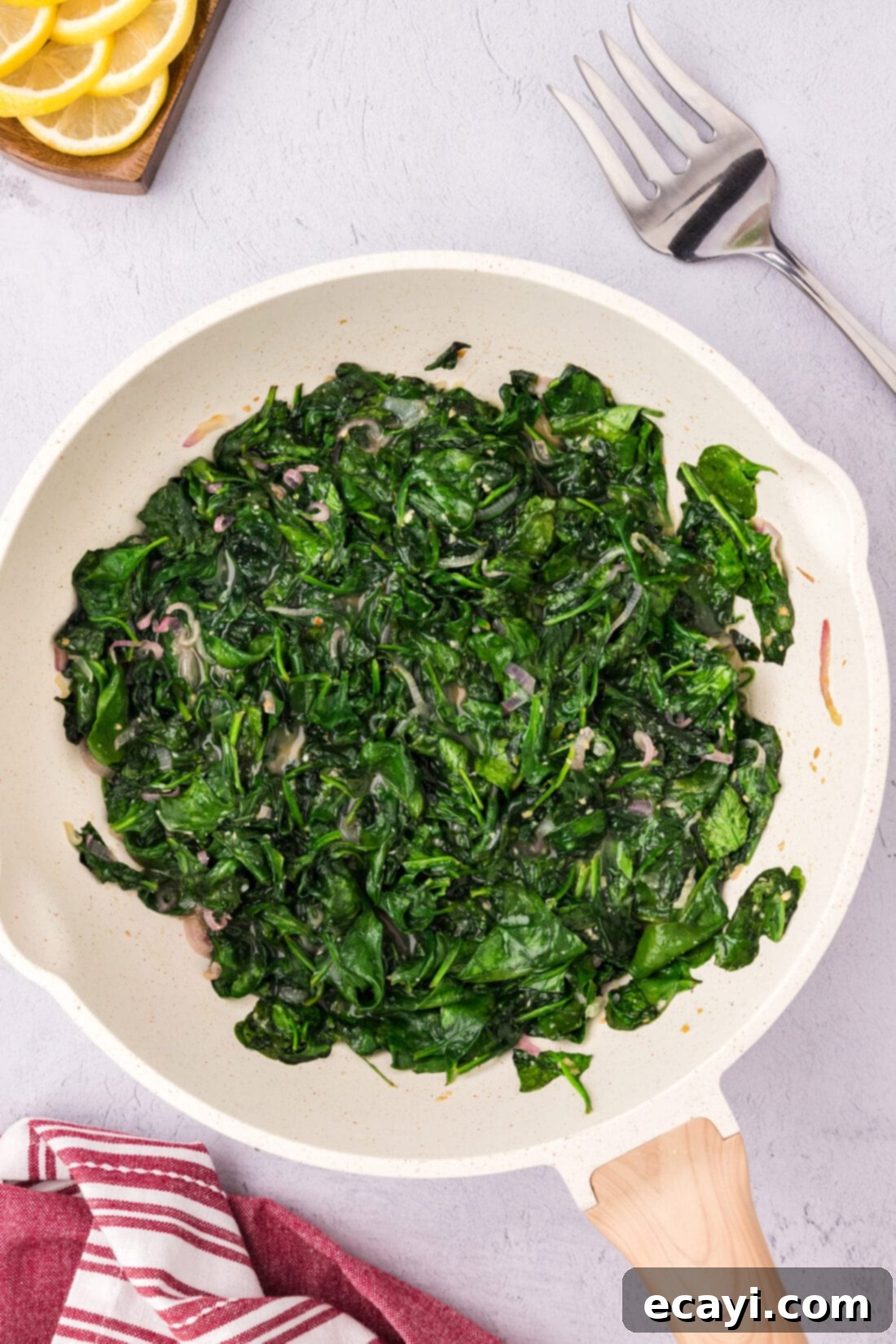
Essential Ingredients for Perfect Sautéed Spinach
Crafting this simple yet spectacular side dish requires just a handful of fresh ingredients that work in harmony to create a truly memorable flavor profile. The full list of measurements, ingredients, and detailed instructions can be found in the printable recipe card at the conclusion of this post. Here’s a quick overview of what you’ll need to gather:
- **Fresh Spinach:** The star of our dish, offering a wealth of nutrients and a delicate texture.
- **Shallots:** Providing a milder, sweeter, and more sophisticated flavor than regular onions, complementing the garlic beautifully.
- **Garlic:** An absolute must for that classic, aromatic foundation.
- **Olive Oil:** The perfect medium to sauté our ingredients, adding a rich, fruity note.
- **Garlic Salt:** For seasoning, enhancing both the garlic flavor and overall savory taste.
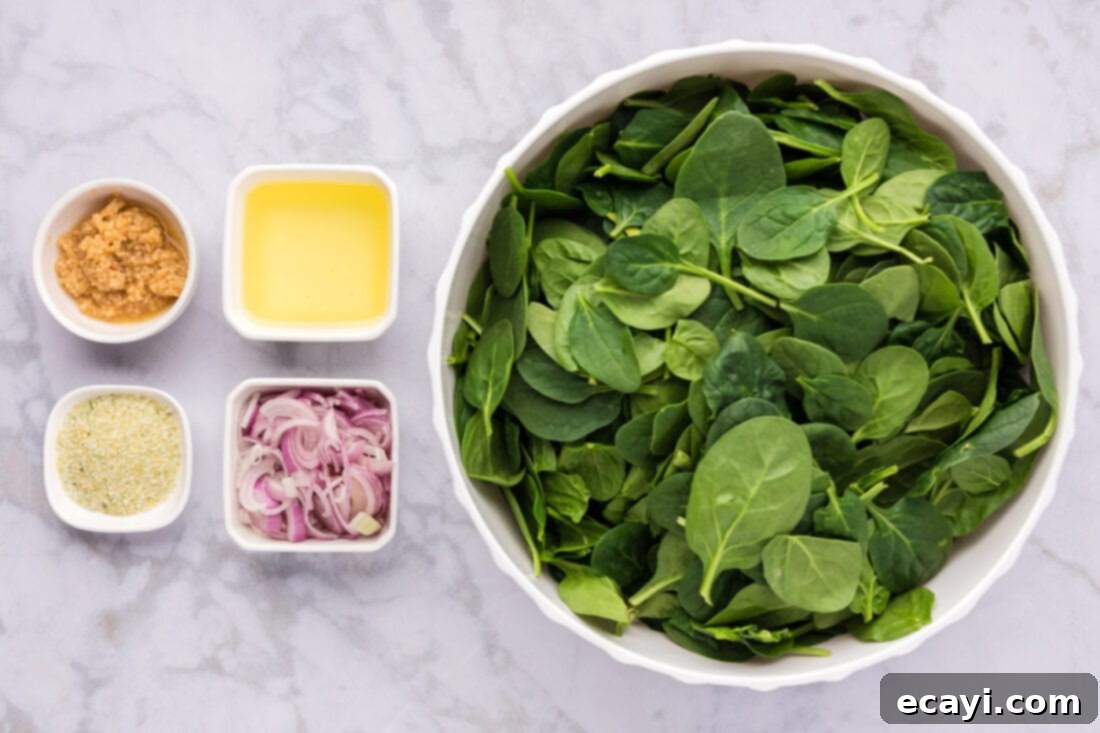
Ingredient Spotlight & Smart Substitutions
Understanding your ingredients and knowing when to make clever substitutions can elevate your cooking and adapt to what you have on hand.
SPINACH – You have options when it comes to spinach! You can use either tender baby spinach or more mature spinach leaves. If opting for mature spinach, we highly recommend trimming the tougher stems before cooking to ensure an even texture. It’s crucial to remember that spinach shrinks considerably when cooked. What might look like an overwhelming mountain of fresh leaves in your skillet will drastically reduce in volume once it wilts down, so don’t be shy about loading up the pan! For best results, use fresh spinach that has been thoroughly washed. Give it a good rinse under cold water, perhaps even two or three times in a large bowl, to remove any grit or dirt, then spin it dry in a salad spinner or pat it dry with paper towels. Excess water can make your sautéed spinach watery instead of perfectly tender-crisp.
GARLIC – Freshly minced garlic is truly unparalleled in this recipe, offering a pungent, sweet aroma that transforms the dish. If you’re short on time, pre-minced garlic from a jar can work in a pinch, but fresh is always superior for flavor. If you don’t have fresh garlic, you could substitute with garlic powder, but remember that the flavor will be less intense and aromatic. Start with about 1/2 teaspoon of garlic powder for every clove of fresh garlic and adjust to taste.
SHALLOTS – Shallots provide a delicate, sweet-savory flavor profile that’s a wonderful bridge between garlic and onion, adding depth without overpowering the spinach. If shallots aren’t available, a good substitute would be a small amount of finely minced yellow onion or a very small leek (white and light green parts, thoroughly washed and finely chopped). The flavor will be slightly different but still delicious.
OLIVE OIL – A good quality extra virgin olive oil not only provides the fat for sautéing but also imparts a lovely, fruity undertone to the finished dish. If you prefer, you can use butter for a richer, more decadent flavor, or a neutral oil like avocado oil or grapeseed oil if you want the spinach and aromatics to shine through more purely.
GARLIC SALT – This ingredient pulls double duty, providing both saltiness and an extra boost of garlic flavor. Feel free to adjust the amount to your personal taste. If you don’t have garlic salt, simply use regular salt (sea salt or kosher salt) and add a little extra fresh garlic or garlic powder. Other optional seasonings include a pinch of red pepper flakes for a subtle kick, a squeeze of fresh lemon juice at the end for brightness, or a sprinkle of nutritional yeast for a cheesy, umami depth.
Mastering the Art of Sautéed Spinach: Step-by-Step Guide
These step-by-step photos and instructions are here to help you visualize how to make this recipe perfectly. For a printable version of this recipe, complete with precise measurements and comprehensive instructions, simply Jump to Recipe at the bottom of this page.
- First, prepare your skillet. Add the olive oil and heat it over medium-high heat. You’ll know it’s ready when the oil begins to shimmer gently, indicating it’s hot enough to properly sauté without burning.
- Once your oil is hot, add the minced garlic and chopped shallots to the skillet. Sauté them for approximately 2 minutes, stirring frequently. The goal here is to soften them and allow their fragrant aromas to develop, but be careful not to brown or burn the garlic, as it can turn bitter.


- Next, add the fresh spinach to the skillet. It will look like a lot, but trust the process! Immediately season the spinach generously with garlic salt to taste. As the spinach heats, it will begin to wilt.

- Continue to cook the spinach, turning it often with tongs or a spatula. Keep cooking until all the leaves are fully wilted and thoroughly warmed through. This usually takes only a few minutes. Avoid overcooking, as spinach can become mushy. Once it’s tender and vibrant green, it’s ready to serve!

Frequently Asked Questions & Expert Tips for Perfect Sautéed Spinach
Absolutely, yes! Sautéed spinach is incredibly healthy. Contrary to some misconceptions, cooking spinach does not diminish its nutritional value significantly, aside from a slight loss of some heat-sensitive Vitamin C. In fact, cooking spinach actually makes certain nutrients more bioavailable, meaning your body can absorb them better. For instance, cooked spinach has been shown to have an increase in Vitamin A and iron compared to raw spinach, as heating helps break down oxalic acid, which can inhibit nutrient absorption. Whichever way you choose to enjoy spinach – raw in salads or cooked in a skillet – rest assured that the vitamins, minerals, and powerful antioxidants you consume are still providing numerous benefits for your overall health and well-being.
To store leftover sautéed spinach, first allow it to cool completely to room temperature. Then, transfer it to an airtight container and store it in the refrigerator for up to 3 days. When reheating, you can gently warm it in a skillet over medium-low heat or in the microwave until just warmed through. Be careful not to overcook it, as this can make it mushy.
While fresh spinach is preferred for its texture, you can certainly use frozen spinach. If using frozen, make sure to thaw it completely and then squeeze out as much excess water as possible. This step is crucial to prevent your sautéed spinach from becoming watery. You can press it between paper towels or use a clean kitchen towel. Once drained, proceed with the recipe as directed, noting that the cooking time might be slightly shorter as it’s already somewhat softened.
The key to preventing watery sautéed spinach lies in a few steps. First, ensure your spinach is thoroughly washed and completely dry before adding it to the pan. Use a salad spinner if you have one! Second, use a large skillet and don’t overcrowd it. If you’re cooking a very large batch, consider working in two smaller batches. This allows the spinach to hit the hot pan and wilt quickly rather than steam in its own juices. Third, maintain medium-high heat throughout the cooking process. High heat helps evaporate moisture quickly.
A large, wide skillet with a heavy bottom is ideal. A stainless steel skillet or a well-seasoned cast-iron skillet both work wonderfully. The wide surface area allows for efficient evaporation of moisture, while the heavy bottom ensures even heat distribution, preventing hot spots and promoting consistent cooking. Using a non-stick pan is also an option for easier cleanup, just be mindful of heating oils to high temperatures if your pan has specific temperature limits.
Absolutely! Sautéed spinach is a fantastic base for incorporating other quick-cooking vegetables. Thinly sliced mushrooms, bell peppers, cherry tomatoes (added towards the end), or even a handful of chopped kale (which will take a bit longer to wilt) would be delicious additions. Add them along with the shallots and garlic, or slightly before, to ensure they cook through properly.
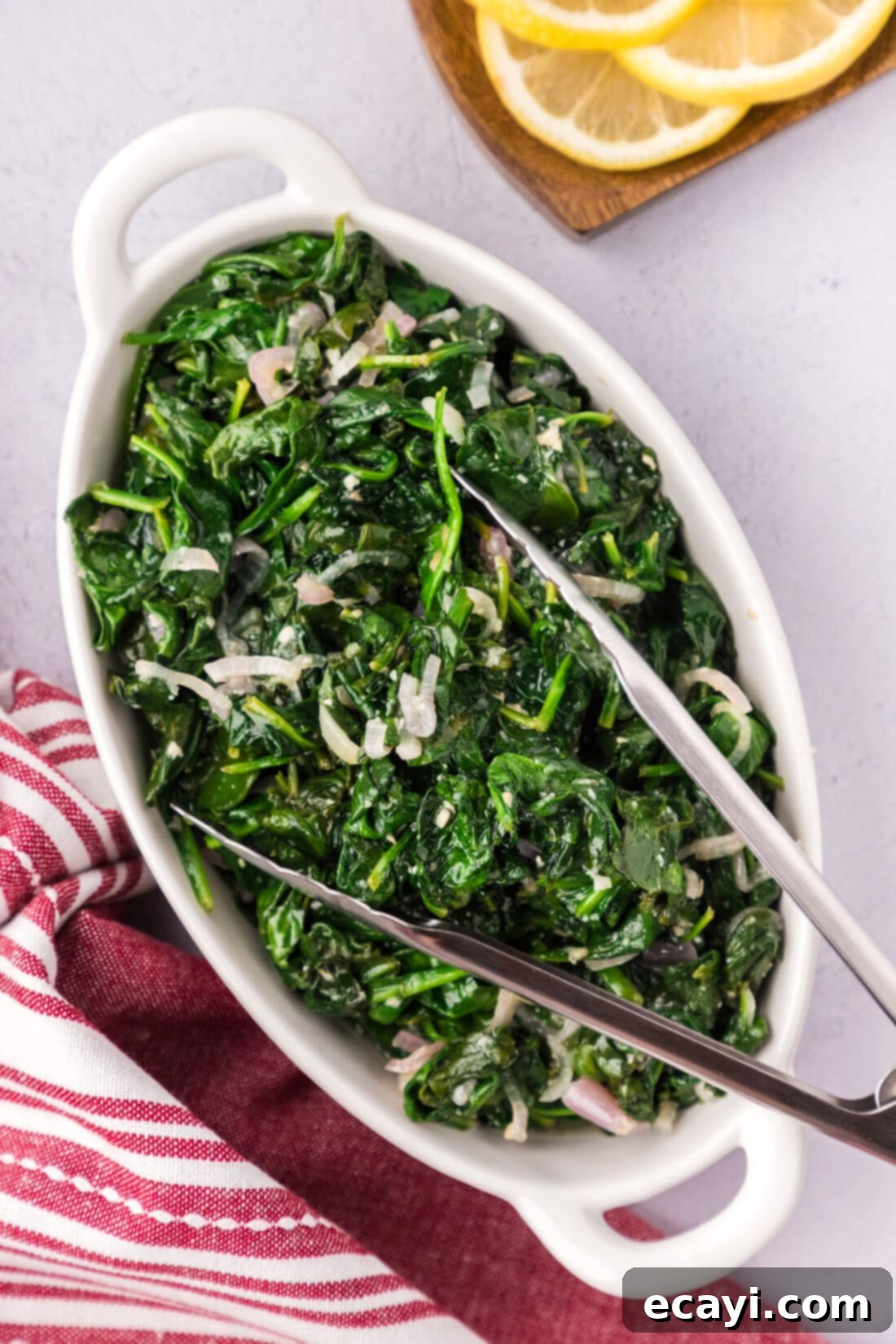
Elevate Your Meal: Delicious Serving Ideas for Sautéed Spinach
Sautéed spinach is far more than just a simple side; it’s a wonderfully adaptable component that can enhance a myriad of dishes, transforming everyday meals into something special. Its delicate flavor profile, boosted by garlic and shallots, makes it a perfect complement to a wide range of proteins and cuisines.
For an optional flourish that adds an extra layer of flavor, consider garnishing your freshly sautéed spinach. A bright squeeze of fresh lemon juice can cut through the richness and add a zesty lift. A generous sprinkle of freshly grated Parmesan cheese introduces a salty, umami depth, while crumbled cooked bacon bits offer a smoky, savory crunch. Other fantastic additions include toasted pine nuts or slivered almonds for texture, or a drizzle of balsamic glaze for a touch of tangy sweetness.
This quick and healthy side pairs exceptionally well with a variety of main courses. Serve it alongside perfectly cooked proteins like grilled chicken breast, seared pork chops, roasted beef tenderloin, or flaky baked fish such as salmon or cod. Its lightness perfectly balances richer main dishes.
But don’t stop there! Sautéed spinach can be a fantastic addition to breakfast and brunch. Fold it into fluffy omelets or mix it into scrambled eggs for a boost of nutrients and flavor to start your day. For lunch, incorporate it into grain bowls with quinoa or farro, or add it to wraps and sandwiches. In the evening, stir it into pasta dishes, layer it onto homemade pizzas, or use it as a flavorful bed for creamy risotto. It’s also an excellent complement to roasted potatoes or other root vegetables.
This recipe is also a brilliant foundation if you’re specifically aiming to create a more intensely flavored garlic spinach. Since it already includes all the necessary base ingredients, you simply need to increase the amount of fresh garlic to achieve that extra savory punch – customize it to truly suit your preferences!
Explore More Delicious & Healthy Recipes
If you loved this simple and healthy sautéed spinach, you’ll be thrilled to discover more delicious recipes that celebrate fresh ingredients and easy preparation. Expand your repertoire of wholesome sides and flavorful dishes with these related favorites:
- Crispy & Flavorful Kale Chips
- Quick & Easy Fried Spinach
- Perfectly Roasted Carrots with Herbs
- Assorted Grilled Vegetables: A Summer Essential
- Indulgent & Creamy Spinach
- Simple & Elegant Sautéed Asparagus
I absolutely love creating and sharing my kitchen experiences with all of you! To make sure you never miss out on a delicious new recipe, I offer a convenient newsletter delivered directly to your inbox every time a new post goes live. Simply subscribe here and start receiving your free daily recipes, bringing fresh inspiration right to your kitchen!
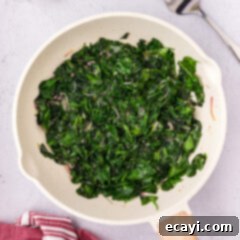
Sautéed Spinach with Garlic & Shallots
IMPORTANT – Don’t forget to check the Frequently Asked Questions (FAQs) section within the blog post above for extra tips and insights that you may find incredibly helpful!
Print It
Pin It
Rate It
Save ItSaved!
Ingredients
- 16 ounces raw spinach leaves (thoroughly washed and dried)
- 3 Tablespoons chopped shallots (finely chopped)
- 2 Tablespoons minced garlic (freshly minced for best flavor)
- 3 Tablespoons olive oil (or other cooking oil of choice)
- garlic salt to taste (or regular salt + a pinch of garlic powder)
Tools You’ll Need
-
Large heavy bottomed skillet
-
Tongs or spatula
-
Salad spinner (optional, for drying spinach)
Before You Begin: Important Notes & Tips
- Spinach shrinks dramatically when cooked. A large mound of raw leaves will reduce significantly, so don’t be concerned if your skillet looks overflowing at the start.
- You can use either baby spinach or more mature spinach. If using mature spinach, remember to trim the tougher stems for a better texture.
- Always wash your spinach thoroughly under cold water to remove any grit. Ensure it is very dry before cooking to prevent a watery result.
- Elevate your sautéed spinach with optional garnishes like a squeeze of fresh lemon juice for brightness, a sprinkle of grated Parmesan cheese for savory depth, or crunchy crumbled bacon bits.
- Sautéed spinach is an incredibly versatile side. It pairs beautifully with a wide array of proteins such as chicken, pork, beef, and seafood. You can also incorporate it into breakfast dishes like omelets or scrambled eggs, or add it to pasta and grain bowls.
Instructions
-
In a large, heavy-bottomed skillet, add the olive oil. Heat the oil over medium-high heat until it begins to shimmer, indicating it’s hot enough for sautéing.
-
Add the minced garlic and chopped shallots to the hot skillet. Sauté for about 2 minutes, stirring constantly, until they are fragrant and softened, but not browned.
-
Add the thoroughly washed and dried spinach leaves to the skillet. It may seem like a lot, but it will quickly reduce. Season generously with garlic salt to taste.
-
Continue to cook the spinach, turning it often with tongs or a spatula, until all the leaves are fully wilted, tender, and warmed through. This should only take 2-4 minutes. Serve immediately and enjoy!
Nutrition Information
The recipes on this blog are tested with a conventional gas oven and gas stovetop. It’s important to note that some ovens, especially as they age, can cook and bake inconsistently. Using an inexpensive oven thermometer can assure you that your oven is truly heating to the proper temperature. If you use a toaster oven or countertop oven, please keep in mind that they may not distribute heat the same as a conventional full sized oven and you may need to adjust your cooking/baking times. In the case of recipes made with a pressure cooker, air fryer, slow cooker, or other appliance, a link to the appliances we use is listed within each respective recipe. For baking recipes where measurements are given by weight, please note that results may not be the same if cups are used instead, and we can’t guarantee success with that method.
